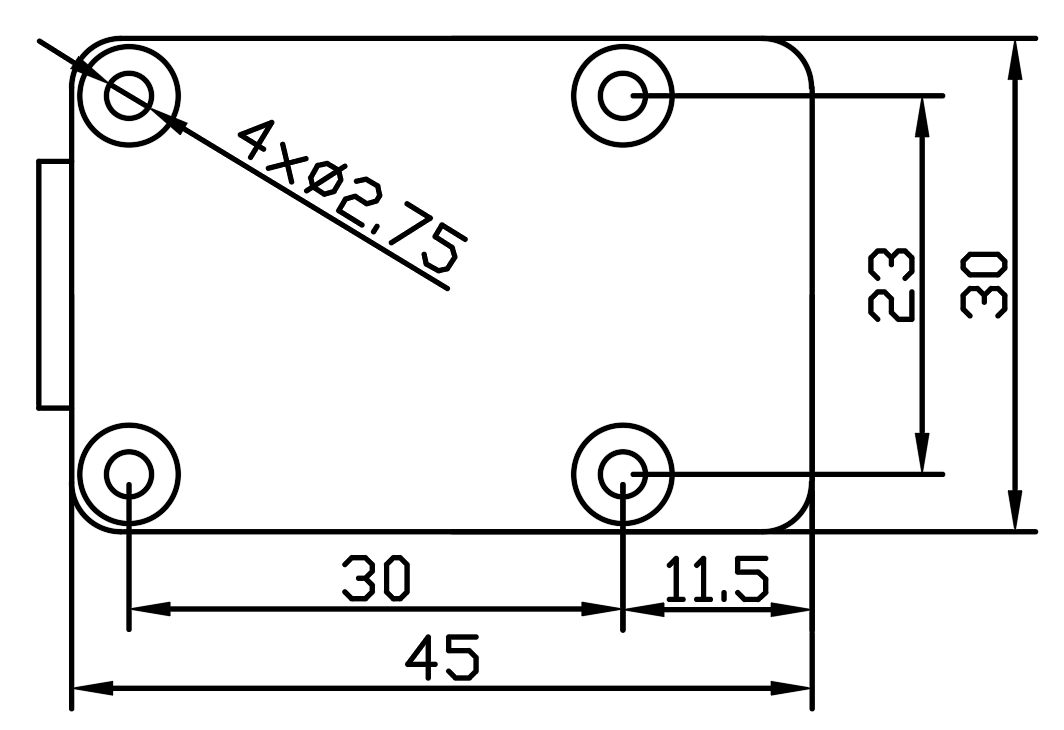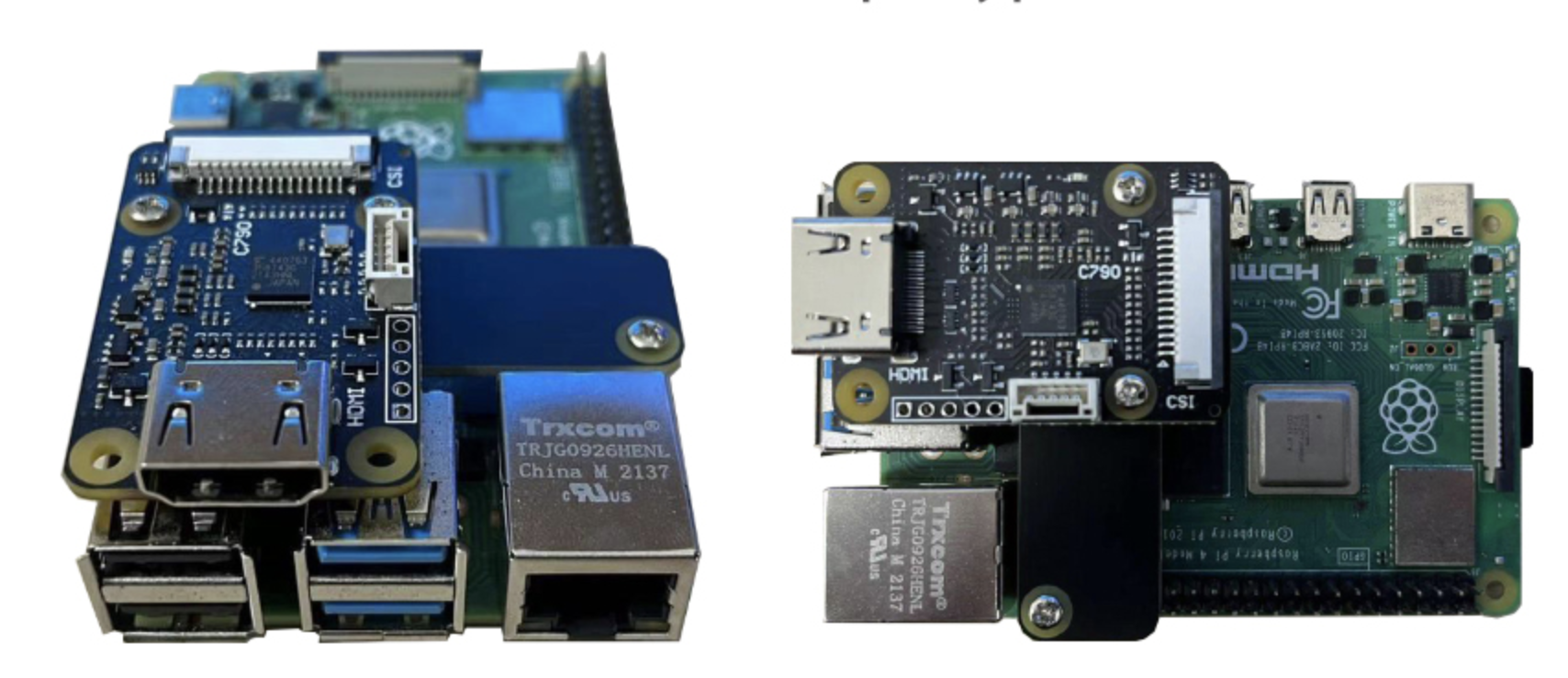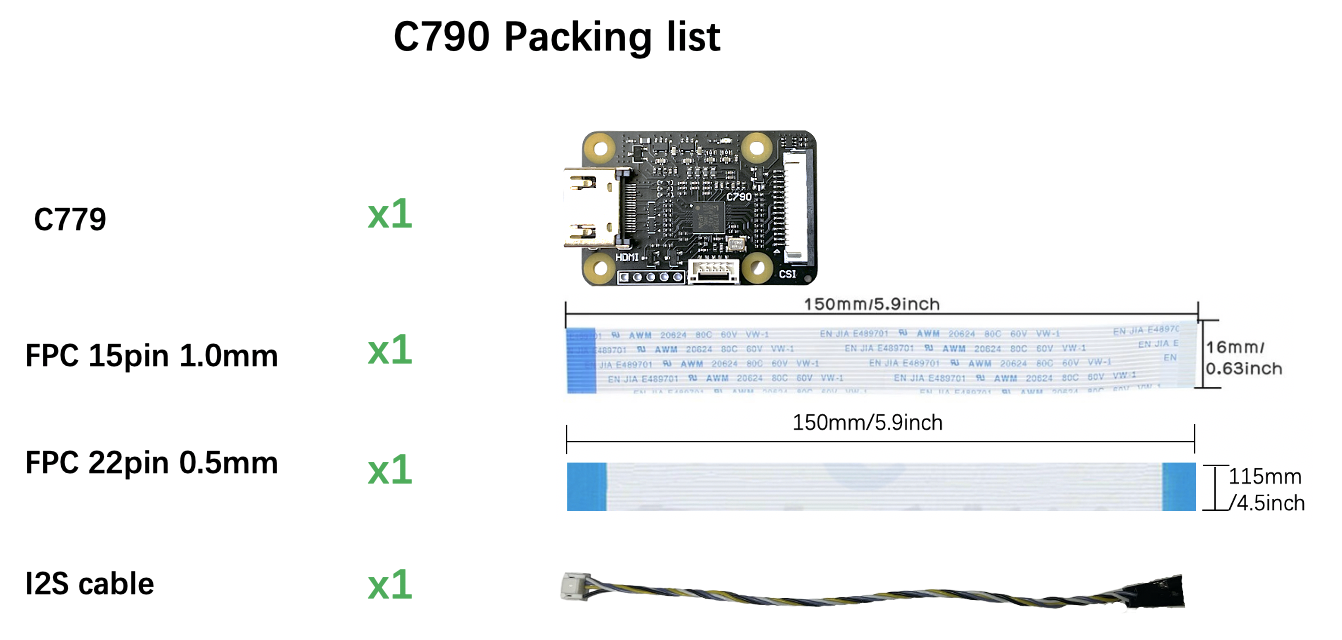HDMI to CSI&I2S bridge guide
Convert HDMI signal acquisition into CSI signal and I2S audio signal. Currently, all platforms are supported (Zero, Pi3B, Pi4B, CM4, Pi5B), and the maximum capture resolution not only depends on the HDMI to CSI converter board you are using but also on the Raspberry Pi hardware version you have. Raspberry Pi hardware versions are primarily divided into two series, one supporting a maximum of 1080P60Hz and the other supporting a maximum of 1080P50Hz.
-
The Raspberry Pi versions that support a maximum of 1080P60Hz are CM3, CM4, and Pi5B.
-
The Raspberry Pi versions that support a maximum of 1080P50Hz are Zero, Zero 2, Pi3B, Pi4B, and so on.
Introduction
This module takes the incoming HDMI signal and converts it into a separate CSI signal and I2S audio signal. HDMI input supports up to 1080P60Hz. It works well on Raspberry Pi, there are three versions of this module in history (C779, C780, C790). C790 is the latest version. C790 has mitigated HDMI backpowering, and also has two csi channels and four csi channels at the same time.
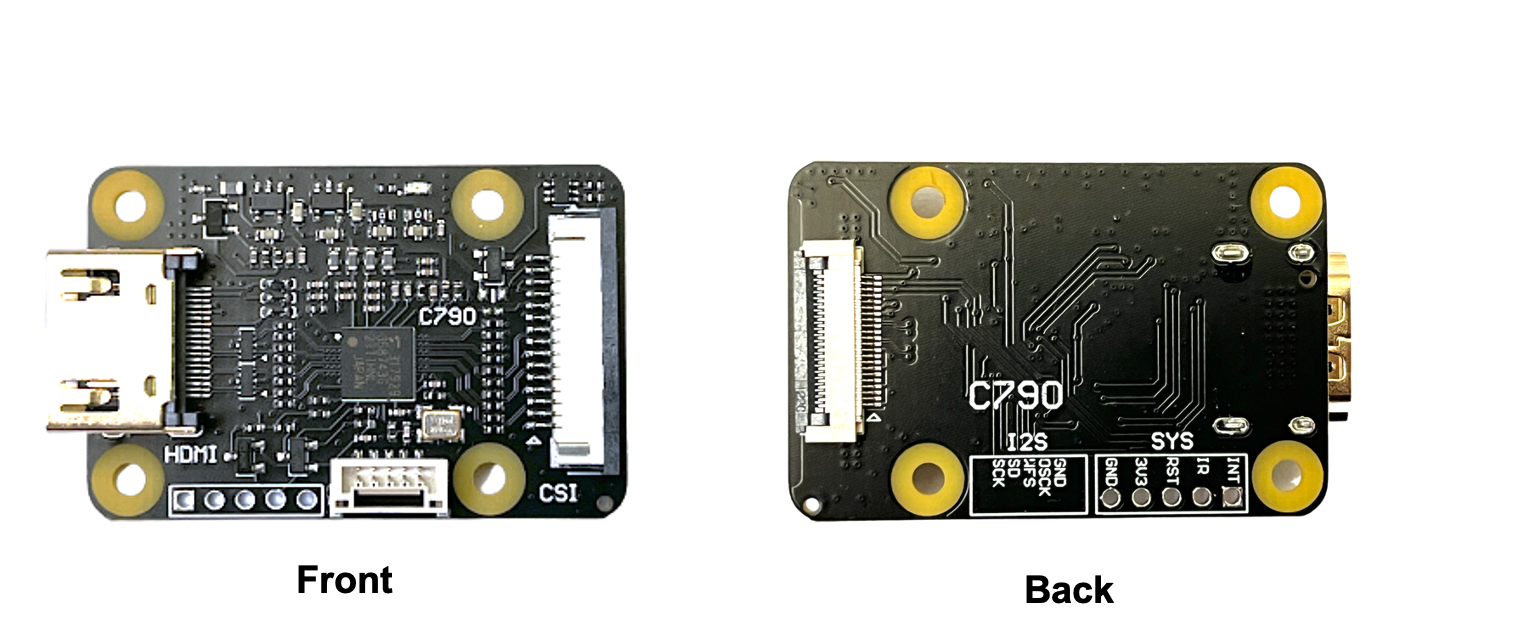
Features
C790
Hardware Parameters
- HDMI input: supports up to 1080P60Hz on Raspberry Pi
- HDMI to CSI-2 bridge chip: Toshiba TC358743XBG
- 4 CSI-2 channels & clock
- The CSI-2 interface, with 15 pin FPC seat, spacing 1.0 mm, is located on the front of the C790 module.
- The CSI-2 interface, with 22 pin FPC seat, spacing 0.5 mm, is located on the back of the C790 module.
- Size: 30 x 45 mm
- Install: 4 x M2.5
- Power supply: 3.3V
- Weight: 10g
Pi 4B only support 1080P50Hz, limited by the number of CSI-2 channels. CM4 support 1080P60HZ, So if you must use 1080P60Hz input, please use CM4 and C790 together.
Interface
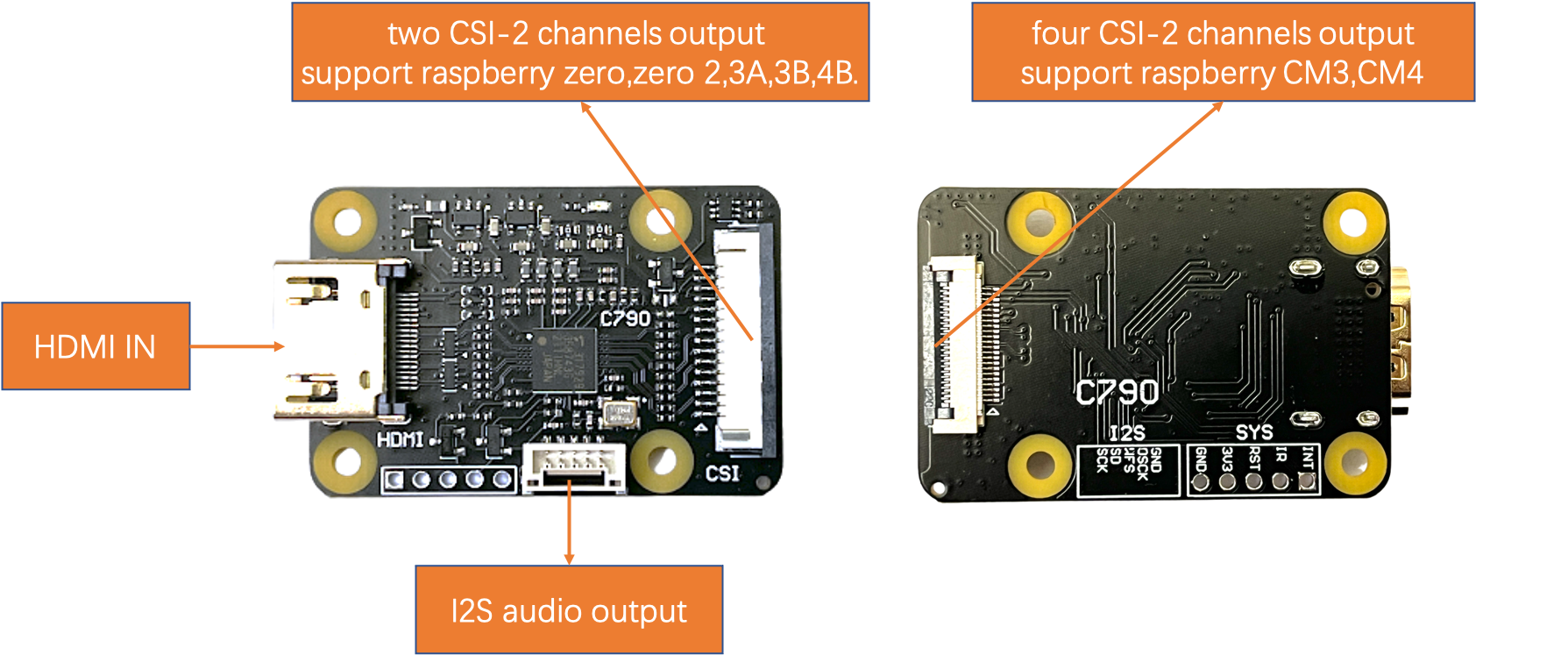 C790 has two CSI output interfaces. In front of C790, the CSI-2 interface is 15 pin FPC seat, spacing 1.0 mm. In back of C790, the CSI-2 interface is 22 pin FPC seat, spacing 0.5 mm.
C790 has two CSI output interfaces. In front of C790, the CSI-2 interface is 15 pin FPC seat, spacing 1.0 mm. In back of C790, the CSI-2 interface is 22 pin FPC seat, spacing 0.5 mm.
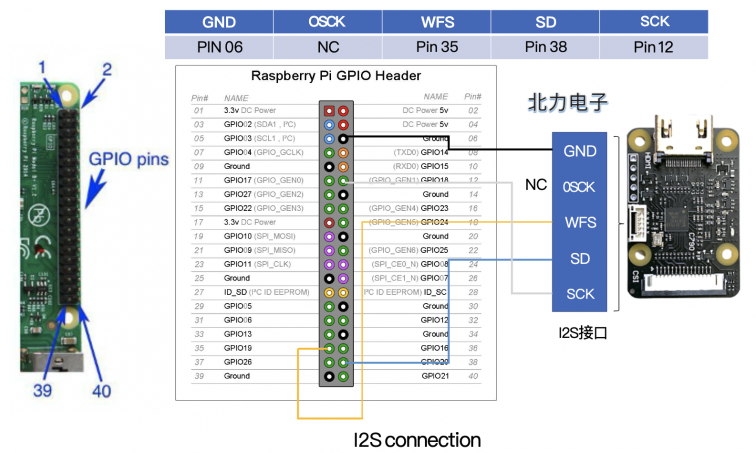
C780
C780A Hardware Parameters
- HDMI input: supports up to 1080P50Hz on Raspberry Pi(Limited by the number of CSI-2 channels)
- HDMI to CSI-2 bridge chip: Toshiba TC358743XBG
- 2 CSI-2 channels & clock
- CSI-2 interface: 15 pin FPC seat, spacing 1.0 mm
- Size: 30 x 65 mm (unbroken PCB size); 30 x 45 mm (PCB size after breaking)
- Install: 6 x M2.5
- Power supply: 3.3V
- Weight: 10g
C780B Hardware Parameters
- HDMI input: supports up to 1080P60Hz on Raspberry Pi
- HDMI to CSI-2 bridge chip: Toshiba TC358743XBG
- 4 CSI-2 channels & clock
- CSI-2 interface: 22 pin FPC seat, spacing 0.5 mm
- Size: 30 x 65 mm (unbroken PCB size); 30 x 45 mm (PCB size after breaking)
- Install: 6 x M2.5
- Power supply: 3.3V
- Weight: 10g
Size
The size of C780 is shown in the image below. There are 6 mounting holes with a diameter of 2.75mm, which are suitable for M2.5 screws.
 As shown in the image below, the user can directly fix the module on the Raspberry Pi Zero. C780 is designed to be broken, and the hole spacing before breaking can be perfectly installed with most series of Raspberry Pi.
As shown in the image below, the user can directly fix the module on the Raspberry Pi Zero. C780 is designed to be broken, and the hole spacing before breaking can be perfectly installed with most series of Raspberry Pi.

C779
Hardware Parameters
- HDMI input: supports up to 1080P50Hz on Raspberry Pi(Limited by the number of CSI-2 channels)
- HDMI to CSI-2 bridge chip: Toshiba TC358743XBG
- 2 CSI-2 channels & clock
- CSI-2 interface: 15 pin FPC seat, spacing 1.0 mm
- Size: 35 x 50 mm
- Install: 4 x M2.5
- Power supply: 3.3V
- Weight: 10g
Size
The size of C779 is shown in Figure. There are 4 mounting holes with a diameter of 2.75mm, which are suitable for M2.5 screws.
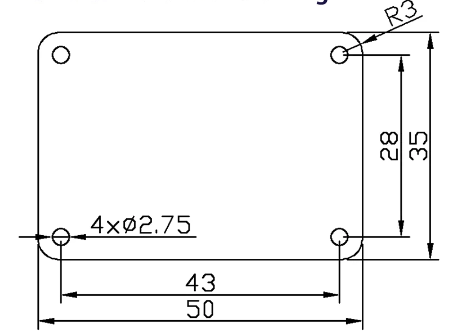
CSI Interface Definitions
The CSI (Camera Serial Interface) interfaces C779 and C780A have 15 pins each, while the C780B interface has 22 pins. The C790 interface is unique as it supports both 15 and 22 PIN configurations.
Software Demo
The use guide of C790/C780/C779 depends on the official Raspberry Pi OS version you are using.
Different versions have different usage methods. If you have some questions, Join our BLIKVM Discord Community for Support, FAQ & News!
To use the kernel drivers, please update your system. There are a few things that have changed with the 5.4 kernel, so these instructions are for 5.4 or later. If uname -a reports anything less, then fix this before proceeding.
pi@raspberrypi:~ $ uname -a
Linux raspberrypi 5.10.63-v7l+ #1459 SMP Wed Oct 6 16:41:57 BST 2021 armv7l GNU/Linux
1. Update & upgrade the Raspberry Pi system (It will take a long time depend on the different country)
2. Enable camera module (the camera is enabled by default in Raspberry pi Bullseys OS)
Navigate to ‘Interfacing Options’ and hit Enter. Now select the ‘Camera’ option, and hit the Enter key to enable it. Select “Finish” and select to reboot your Raspberry Pi. reboot is important!!Due to the absence of hardware encoding on the Pi5B, the software usage instructions for Pi platforms are currently divided into two sections: Pi5B configuration and configuration for other Pi platforms.
In platforms such as Zero, Zero 2, Pi3B, Pi4B, etc., there is a reference for testing HDMI to CSI module demo.
Edit /boot/config.txt (that will need sudo)
Add the line: Add the line if your shield support audio like C780 or C790. If (and only if) you have a device such as the C780 or C790 that supports the 22pin connector with all 4 lanes wired out, and are using a Compute Module with the CAM1 connector that also has all 4 lanes wired up, you can use: Check the amount of memory assigned to the CMA heap with “dmesg | grep cma”. The first line should be along the lines of: If it reports less than 96MB assigned to CMA, then edit /boot/cmdline.txt and add to the start of the line. Do NOT add any carriage returns. Reboot. If all is well you should get a /dev/video0 device, and “v4l2-ctl –list-devices” will tell you that it is provided by Unicam. After connecting all the cables, power on the Raspberry Pi, the C790 indicator light is normally green, and after opening the Raspberry Pi terminal, enter the following command:pi@raspberrypi:~ $ ls /dev/video0
/dev/video0
pi@raspberrypi:~ $ v4l2-ctl --list-devices
bcm2835-codec-decode (platform:bcm2835-codec):
/dev/video10
/dev/video11
/dev/video12
/dev/video18
/dev/media1
bcm2835-isp (platform:bcm2835-isp):
/dev/video13
/dev/video14
/dev/video15
/dev/video16
/dev/media0
unicam (platform:fe801000.csi):
/dev/video0
/dev/video1
/dev/media2
00ffffffffffff005262888800888888
1c150103800000780aEE91A3544C9926
0F505400000001010101010101010101
010101010101011d007251d01e206e28
5500c48e2100001e8c0ad08a20e02d10
103e9600138e2100001e000000fc0054
6f73686962612d4832430a20000000FD
003b3d0f2e0f1e0a2020202020200100
020321434e041303021211012021a23c
3d3e1f2309070766030c00300080E300
7F8c0ad08a20e02d10103e9600c48e21
0000188c0ad08a20e02d10103e960013
8e210000188c0aa01451f01600267c43
00138e21000098000000000000000000
00000000000000000000000000000000
00000000000000000000000000000000
cd ~
sudo nano edid.txt
#copy the above commend in edid.txt, save&exit;
pi@raspberrypi:~ $ v4l2-ctl --set-edid=file=edid.txt --fix-edid-checksums
CTA-861 Header
IT Formats Underscanned: yes
Audio: yes
YCbCr 4:4:4: no
YCbCr 4:2:2: no
HDMI Vendor-Specific Data Block
Physical Address: 3.0.0.0
YCbCr 4:4:4 Deep Color: no
30-bit: no
36-bit: no
48-bit: no
CTA-861 Video Capability Descriptor
RGB Quantization Range: yes
YCC Quantization Range: no
PT: Supports both over- and underscan
IT: Supports both over- and underscan
CE: Supports both over- and underscan
pi@raspberrypi:~ $ v4l2-ctl --query-dv-timings
Active width: 1280
Active height: 720
Total width: 1650
Total height: 750
Frame format: progressive
Polarities: -vsync -hsync
Pixelclock: 74250000 Hz (60.00 frames per second)
Horizontal frontporch: 0
Horizontal sync: 370
Horizontal backporch: 0
Vertical frontporch: 0
Vertical sync: 30
Vertical backporch: 0
Standards:
Flags:
pi@raspberrypi:~ $ arecord -l
**** List of CAPTURE Hardware Devices ****
card 1: tc358743 [tc358743], device 0: bcm2835-i2s-dir-hifi dir-hifi-0 [bcm2835-i2s-dir-hifi dir-hifi-0]
Subdevices: 1/1
Subdevice #0: subdevice #0
Install GStreamer tool.
Check gstreamer tool version:pi@raspberrypi:~ $ gst-launch-1.0 --version
gst-launch-1.0 version 1.18.4
GStreamer 1.18.4
http://packages.qa.debian.org/gstreamer1.0
Use gstreamer to record video and audio
#GStreamer v1.14 command
gst-launch-1.0 v4l2src io-mode=5 ! video/x-raw, format=UYVY, framerate=25/1 ! v4l2h264enc output-io-mode=4 ! video/x-h264,profile=high ! h264parse ! queue ! matroskamux name=mux ! filesink location=foo.mkv alsasrc device=hw:1 ! audio/x-raw,rate=48000,channels=2 ! audioconvert ! avenc_aac bitrate=48000 ! aacparse ! queue ! mux.
#The command to recode a video with audio. (GStreamer 1.18.4)
gst-launch-1.0 -vvv v4l2src ! "video/x-raw,framerate=30/1,format=UYVY" ! v4l2h264enc extra-controls="controls,h264_profile=4,h264_level=13,video_bitrate=256000;" ! "video/x-h264,profile=high, level=(string)4.2" ! h264parse ! queue ! matroskamux name=mux ! filesink location=foo.mkv alsasrc device=hw:1 ! audio/x-raw,rate=48000,channels=2 ! audioconvert ! avenc_aac bitrate=48000 ! aacparse ! queue ! mux.
#The sample command to recode a video without audio. (C779 doesn't support audio)
gst-launch-1.0 -vvv v4l2src ! "video/x-raw,framerate=30/1,format=UYVY" ! v4l2h264enc extra-controls="controls,h264_profile=4,h264_level=13,video_bitrate=256000;" ! "video/x-h264,profile=high, level=(string)4.2" ! h264parse ! queue ! matroskamux name=mux ! filesink location=foo.mkv
Press CTRL+C to end recording.
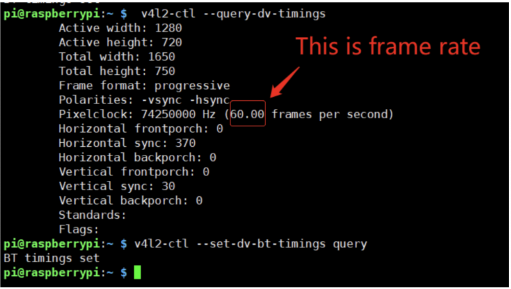 For the above HDMI device, because the frame rate is 60, so we modify the framerate parameter to 60 like the followint command.
Record the video only:
For the above HDMI device, because the frame rate is 60, so we modify the framerate parameter to 60 like the followint command.
Record the video only:
gst-launch-1.0 -vvv v4l2src ! "video/x-raw,framerate=60/1,format=UYVY" ! v4l2h264enc extra-controls="controls,h264_profile=4,h264_level=13,video_bitrate=256000;" ! "video/x-h264,profile=high, level=(string)4.2" ! h264parse ! queue ! matroskamux name=mux ! filesink location=foo.mkv
gst-launch-1.0 -vvv v4l2src ! "video/x-raw,framerate=60/1,format=UYVY" ! v4l2h264enc extra-controls="controls,h264_profile=4,h264_level=13,video_bitrate=256000;" ! "video/x-h264,profile=high, level=(string)4.2" ! h264parse ! queue ! matroskamux name=mux ! filesink location=foo.mkv alsasrc device=hw:1 ! audio/x-raw,rate=48000,channels=2 ! audioconvert ! avenc_aac bitrate=48000 ! aacparse ! queue ! mux.
Pi5B platforms HDMI to CSI module test demo reference.
In the following test, the CAM1 channel is used, and the input resolution is 1080P24Hz. During the Raspberry Pi 5B test, it was found that the EDID settings were invalid, so an HDMI emulator needs to be added to force the target to output HDMI. Otherwise, the Raspberry Pi 5B may not receive any input. Due to the lack of corresponding hardware encoding on the Raspberry Pi 5B, the image capture performance of the Raspberry Pi 5B + C790 is generally inferior to that of the Raspberry Pi 4B.
Edit /boot/config.txt (sudo permission required).
Add the following content: If your modules (C780 and C790) support audio, add the following content to enable audio support. Reboot the Raspberry Pi and execute the following command to find the media node corresponding to the CSI as media0, under the rp1-cfe (platform: 1f00128000.csi) field:blikvm@blikvm:~ $ v4l2-ctl --list-devices
pispbe (platform:1000880000.pisp_be):
/dev/video20
/dev/video21
/dev/video22
/dev/video23
/dev/video24
/dev/video25
/dev/video26
/dev/video27
/dev/video28
/dev/video29
/dev/video30
/dev/video31
/dev/video32
/dev/video33
/dev/video34
/dev/video35
/dev/video36
/dev/video37
/dev/media1
/dev/media2
rp1-cfe (platform:1f00128000.csi):
/dev/video0
/dev/video1
/dev/video2
/dev/video3
/dev/video4
/dev/video5
/dev/video6
/dev/video7
/dev/media0
rpivid (platform:rpivid):
/dev/video19
/dev/media3
Locate the node corresponding to tc358743 as v4l-subdev2, and the pad0 of rp1-cfe-csi2_ch0 as video0:
blikvm@blikvm:~ $ media-ctl -d /dev/media0 -p
Media controller API version 6.1.63
Media device information
------------------------
driver rp1-cfe
model rp1-cfe
serial
bus info platform:1f00128000.csi
hw revision 0x114666
driver version 6.1.63
Device topology
- entity 1: csi2 (8 pads, 8 links)
type V4L2 subdev subtype Unknown flags 0
device node name /dev/v4l-subdev0
pad0: Sink
[fmt:SRGGB10_1X10/640x480 field:none colorspace:raw xfer:none ycbcr:601 quantization:full-range]
<- "tc358743 4-000f":0 [ENABLED,IMMUTABLE]
pad1: Sink
[fmt:unknown/8192x1 field:none]
pad2: Sink
[fmt:SRGGB10_1X10/640x480 field:none colorspace:raw xfer:none ycbcr:601 quantization:full-range]
pad3: Sink
[fmt:SRGGB10_1X10/640x480 field:none colorspace:raw xfer:none ycbcr:601 quantization:full-range]
pad4: Source
[fmt:SRGGB10_1X10/640x480 field:none colorspace:raw xfer:none ycbcr:601 quantization:full-range]
-> "rp1-cfe-csi2_ch0":0 []
-> "pisp-fe":0 []
pad5: Source
[fmt:unknown/8192x1 field:none]
-> "rp1-cfe-embedded":0 []
pad6: Source
[fmt:SRGGB10_1X10/640x480 field:none colorspace:raw xfer:none ycbcr:601 quantization:full-range]
-> "rp1-cfe-csi2_ch2":0 []
-> "pisp-fe":0 []
pad7: Source
[fmt:SRGGB10_1X10/640x480 field:none colorspace:raw xfer:none ycbcr:601 quantization:full-range]
-> "rp1-cfe-csi2_ch3":0 []
-> "pisp-fe":0 []
- entity 10: pisp-fe (5 pads, 7 links)
type V4L2 subdev subtype Unknown flags 0
device node name /dev/v4l-subdev1
pad0: Sink
[fmt:SRGGB16_1X16/640x480 field:none colorspace:raw xfer:none ycbcr:601 quantization:full-range]
<- "csi2":4 []
<- "csi2":6 []
<- "csi2":7 []
pad1: Sink
[fmt:FIXED/8192x1 field:none]
<- "rp1-cfe-fe_config":0 []
pad2: Source
[fmt:SRGGB16_1X16/640x480 field:none colorspace:raw xfer:none ycbcr:601 quantization:full-range]
-> "rp1-cfe-fe_image0":0 []
pad3: Source
[fmt:SRGGB16_1X16/640x480 field:none colorspace:raw xfer:none ycbcr:601 quantization:full-range]
-> "rp1-cfe-fe_image1":0 []
pad4: Source
[fmt:FIXED/8192x1 field:none]
-> "rp1-cfe-fe_stats":0 []
- entity 16: tc358743 4-000f (1 pad, 1 link)
type V4L2 subdev subtype Unknown flags 0
device node name /dev/v4l-subdev2
pad0: Source
[fmt:RGB888_1X24/640x480 field:none colorspace:srgb]
[dv.caps:BT.656/1120 min:640x350@13000000 max:1920x1200@165000000 stds:CEA-861,DMT,CVT,GTF caps:progressive,reduced-blanking,custom]
[dv.detect:BT.656/1120 1920x1080p24 (2750x1125) stds: flags:]
[dv.current:BT.656/1120 640x480p59 (800x525) stds:CEA-861,DMT flags:has-cea861-vic]
-> "csi2":0 [ENABLED,IMMUTABLE]
- entity 18: rp1-cfe-csi2_ch0 (1 pad, 1 link)
type Node subtype V4L flags 0
device node name /dev/video0
pad0: Sink
<- "csi2":4 []
- entity 22: rp1-cfe-embedded (1 pad, 1 link)
type Node subtype V4L flags 0
device node name /dev/video1
pad0: Sink
<- "csi2":5 []
- entity 26: rp1-cfe-csi2_ch2 (1 pad, 1 link)
type Node subtype V4L flags 0
device node name /dev/video2
pad0: Sink
<- "csi2":6 []
- entity 30: rp1-cfe-csi2_ch3 (1 pad, 1 link)
type Node subtype V4L flags 0
device node name /dev/video3
pad0: Sink
<- "csi2":7 []
- entity 34: rp1-cfe-fe_image0 (1 pad, 1 link)
type Node subtype V4L flags 1
device node name /dev/video4
pad0: Sink
<- "pisp-fe":2 []
- entity 38: rp1-cfe-fe_image1 (1 pad, 1 link)
type Node subtype V4L flags 0
device node name /dev/video5
pad0: Sink
<- "pisp-fe":3 []
- entity 42: rp1-cfe-fe_stats (1 pad, 1 link)
type Node subtype V4L flags 0
device node name /dev/video6
pad0: Sink
<- "pisp-fe":4 []
- entity 46: rp1-cfe-fe_config (1 pad, 1 link)
type Node subtype V4L flags 0
device node name /dev/video7
pad0: Source
-> "pisp-fe":1 []
blikvm@blikvm:~ $ v4l2-ctl -d /dev/v4l-subdev2 --query-dv-timings
Active width: 1920
Active height: 1080
Total width: 2750
Total height: 1125
Frame format: progressive
Polarities: -vsync -hsync
Pixelclock: 74250000 Hz (24.00 frames per second)
Horizontal frontporch: 0
Horizontal sync: 830
Horizontal backporch: 0
Vertical frontporch: 0
Vertical sync: 45
Vertical backporch: 0
Standards:
Flags:
blikvm@blikvm:~ $ media-ctl -d /dev/media0 -V ''\''csi2'\'':0 [fmt:RGB888_1X24/1920x1080 field:none colorspace:srgb]'
blikvm@blikvm:~ $ media-ctl -d /dev/media0 -V ''\''csi2'\'':4 [fmt:RGB888_1X24/1920x1080 field:none colorspace:srgb]'
Chip Docs
Packing List
Test Video
Purchase Link
Created: June 5, 2022
